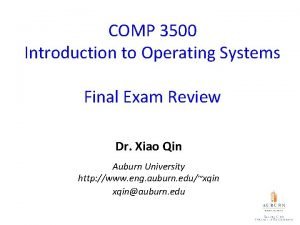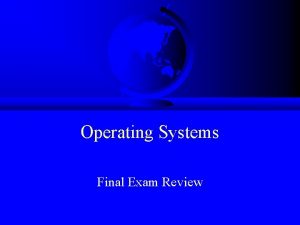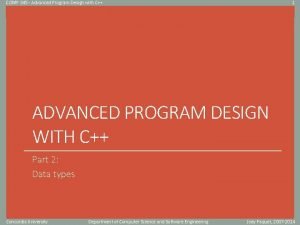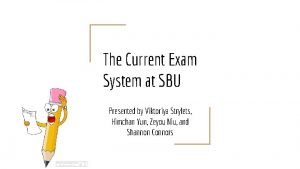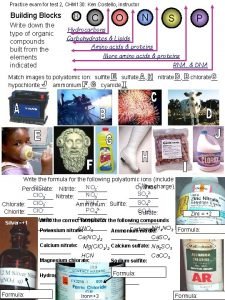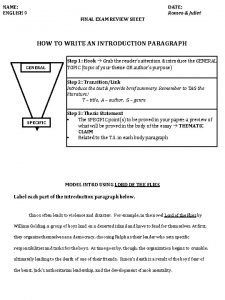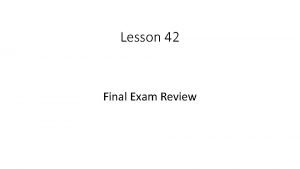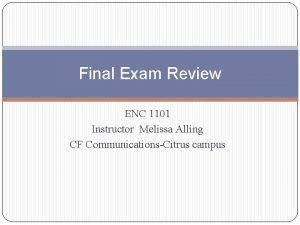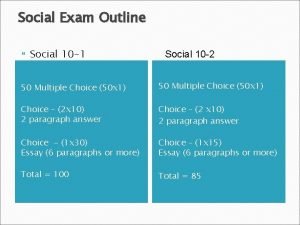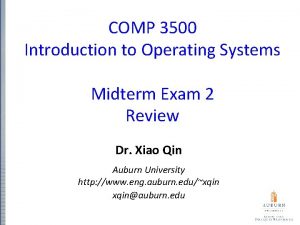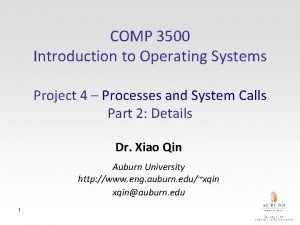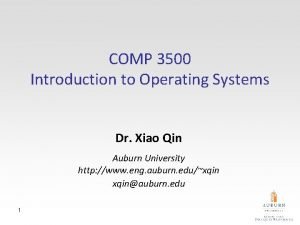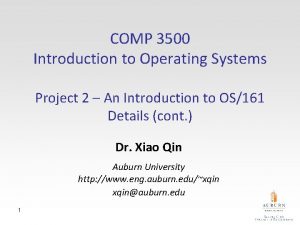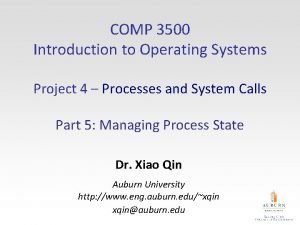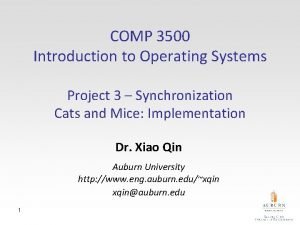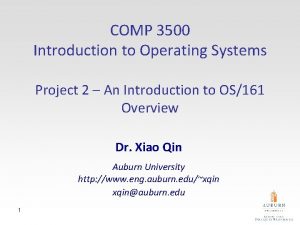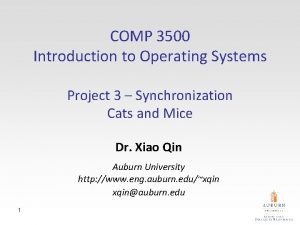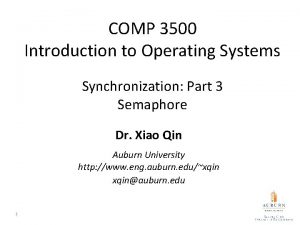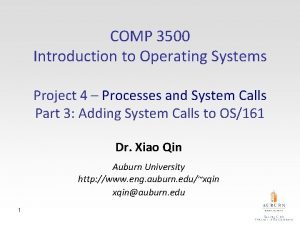COMP 3500 Introduction to Operating Systems Final Exam






































































- Slides: 70

COMP 3500 Introduction to Operating Systems Final Exam Review Dr. Xiao Qin Auburn University http: //www. eng. auburn. edu/~xqin@auburn. edu

Paging • Partition memory into equal fixed-size chunks that are relatively small • Process is also divided into small fixed-size chunks of the same size 2

Page Table • Maintained by operating system for each process • Contains the frame location for each page in the process • Processor must know how to access for the current process • Used by processor to produce a physical address 3

How to use a page table to perform logical -to-physical address translations? 4

Logical-to-Physical Address Translation Scheme • Address generated by CPU is divided into: – Page number (p) – used as an index into a page table which contains base address of each page in physical memory – Page offset (d) – combined with base address to define the physical memory address that is sent to the memory unit – For given logical address space 2 m and page size 2 n

Logical-to-Physical Address Translations 6

Page Table: An Example 1. What is the size of physical memory? 2. What is the page size? 3. How many bits are used as an index into a page table? 4. How many bits are used for page offset? 7

Calculating Internal Fragmentation • Page size = 2, 048 bytes • Process size = 72, 766 bytes 1. 2. 3. 4. 5. How many pages are there in this process? How many bytes are there in the last page? What is the internal fragment? What is the worst case fragmentation? What is the average fragmentation?

Are small frame sizes desirable? • Small frame size: small fragment • Small frame size: large table size – each page table entry takes memory to track • Page sizes growing over time – Solaris supports two page sizes – 8 KB and 4 MB

Two registers to support paging (1) Where should we keep page tables? (2) Where does the Page-table base register (PTBR) point at? (3) The Page-table length register (PTLR) indicates size of the page table. Why the Page-table length register (PTLR) is important?

Paging Hardware with Translation Look-aside Buffers (TLB) 11

Parallel Searching the TLB • Associative memory – parallel search • Address translation (p, d) – If p is in associative register, get frame # out – Otherwise get frame # from page table in memory

What happens on a TLB miss? Replacement policies must Value (? ) is loaded into the TLB for faster access next time be considered 13

Paging and Translation Lookaside Buffer (TLB) 14

Page-table Base Register (Page Table Pointer) 15

Two-Level Page Table 4 KB root page table 1. How many root page table entries? User Page Table 2. How many user page table entries? 3. How large is the user 16 address space? Assume (1) we have 4 -byte page table entry. (2) page size is 4 KB

Address Translation in the Two. Level Paging System 17

Design virtual address format for a two-level paging system • Suppose you design a two-level page translation scheme where page size is 16 MB and page table entry size is 16 bytes. • What is the format of a 64 -bit virtual address?

Memory Accesses in the Paging Scheme • To load an instruction or data from main memory, how many memory accesses are required in the paging scheme? – two memory accesses – One for the page table and one for the data / instruction • What is the problem with respect to memory access? – The two memory access problem can be solved by the use of a special fast-lookup hardware cache called associative memory or translation look-aside buffers (TLBs)

Address Space ID in TLBs • Why some TLBs store address-space identifiers (ASIDs) in each TLB entry – uniquely identifies each process? To provide address-space protection for that process

Effective Memory Access Time • Associative Lookup = Ttlb time unit • TLB hit ratio = h – percentage of times that a page number is found in the associative registers; T_hit = T_tlb + T_mem T_miss = T_tlb + T_mem + T_tlb_update + T_mem access page table access data T_miss = T_tlb + T_mem Effective Access Time = h*T_hit + (1 -h)*T_miss

Effective Access Time • Consider a single-level paging scheme. The TLB has 32 entries. The TLB access time is 10 ns; memory access time is 200 ns. 1. How long does it take to access data in memory if there is a TLB hit? 2. How long does it take to access data in memory if there is a TLB miss? 3. What is the effective memory-access time if we have a TLB hit ratio of 80%? 4. What is the minimal hit ratio that guarantees the effective access time of at most 220 ns?

Segment Organization • Each segment table entry contains the starting address of the corresponding segment in main memory and the length of the segment • A bit is needed to determine if the segment is already in main memory • Another bit is needed to determine if the segment has been modified since it was loaded in main memory 23

Address Translation in a Segmentation System 24

Combined Paging and Segmentation A user’s address space is broken up into a number of segments. Each segment is broken up into a number of fixed-sized pages Each page is equal in length to a main memory frame 25 Segmentation is visible to the programmer Paging is transparent to the programmer

Address Translation in a Segmentation/Paging System

27

Fetch Policy Determines when a page should be brought into memory Two main types: Demand Paging 28 Prepaging

Demand Paging • Brings pages into main memory when a reference is made to a location on the page Many or few page faults when process is first started? What happens after more and more pages are brought in? • Principle of locality suggests that as, most future references will be to pages that have recently been brought in, and page faults should drop to a very low level 29

Prepaging • Pages other than the one demanded by a page fault are brought in • Exploits the characteristics of most secondary memory devices • If pages of a process are stored contiguously in secondary memory it is more efficient to bring in a number of pages at one time What is the downside? Ineffective if extra pages are not referenced 30

Placement Policy • Determines where in real memory a process piece is to reside • Important design issue in a segmentation system • Paging or combined paging with segmentation placing is irrelevant because hardware performs functions with equal efficiency • For NUMA systems an automatic placement strategy is desirable 31

Replacement Policy • Deals with the selection of a page in main memory to be replaced when a new page must be brought in • Objective: the page that is removed should be the page least likely to be referenced in the near future The more elaborate the replacement policy the greater the hardware and software overhead to implement it 32

Basic Algorithms used for the selection of a page to replace: • Optimal • Least recently used (LRU) • First-in-first-out (FIFO) • Clock 33

Least Recently Used (LRU) • Replaces the page that has not been referenced for the longest time • By the principle of locality, this should be the page least likely to be referenced in the near future 34

Amazon Interview Question for Software Engineer / Developers • Implement an LRU cache How to implement LRU? – one approach is to tag each page with the time of last reference – this requires a great deal of overhead 35

First-in-First-out (FIFO) • Treats page frames allocated to a process as a circular buffer • Pages are removed in round-robin style • A Simple replacement policy to implement • Page that has been in memory the longest is replaced 36

37

File Management • File is a named, ordered collection of information What are a file manager’s responsibilities? – – Storing the information on a device Mapping the block storage to a logical view Allocating/deallocating storage Providing file directories

Information Structure Applications Records Structured Record Files Record-Stream Translation Byte Stream Files Stream-Block Translation Storage device

Can you design the following byte stream file interface? file. ID = open(file. Name) close(file. ID) read(file. ID, buffer, length) write(file. ID, buffer, length) seek(file. ID, file. Position)

Low Level Files fid = open(“file. Name”, …); … read(fid, buflen); … close(fid); int int int b 0 b 1 b 2 open(…) {…} close(…) {…} read(…) {…} write(…) {…} seek(…) {…} Storage device response to commands . . . bi . . . Stream-Block Translation

Structured Files Record-Block Translation

Record-Oriented Sequential Files Logical Record file. ID = open(file. Name) close(file. ID) get. Record(file. ID, record) put. Record(file. ID, record) seek(file. ID, position)

File Operations File is an abstract data type Create Write Read Reposition within file Delete Truncate Open(Fi) – search the directory structure on disk for entry Fi, and move the content of entry to memory • Close (Fi) – move the content of entry Fi in memory to directory structure on disk • •

Implementing Low Level Files Secondary storage device contains ? n Volume directory (sometimes a root directory for a file system) n External file descriptor for each file n The file contents • Manages blocks • Assigns blocks to files (descriptor keeps track) • Keeps track of available blocks • Maps to/from byte stream

File Descriptors • • • • External name Current state Sharable Owner User Locks Protection settings Length Time of creation Time of last modification Time of last access Reference count Storage device details How to design a file control block (a. k. a. , file descriptor)? From “File Systems Requirements” to “File Attributes” From “File Attributes” to “a File Control Block”

In-Memory File System Structures

An open() Operation • Locate the on-device (external) file descriptor • Extract info needed to read/write file • Authenticate that process can access the file • Create an internal file descriptor in primary memory (“System-wide”) • Create an entry in a “per process” open file status table • Allocate resources, e. g. , buffers, to support file usage

File Manager Data Structures 2 Keep the state of the processfile session 3 Return a reference to the data structure Process-File Session Open File Descriptor External File Descriptor 1 Copy info from external to the open file descriptor

Schematic View of a Virtual File System 50

Single-Level Directory • A single directory for all users Good News? Problems? Naming problem 51 Grouping problem

Two-Level Directory • Separate directory for each user Advantages? Problems? • Path name • Can have the same file name for different user • Efficient searching 52 • No grouping capability

Tree-Structured Directories 53

Block Management • The job of selecting & assigning storage blocks to the file • For a fixed sized file of k blocks – File of length m requires N = m/k blocks – Byte bi is stored in block i/k • Three basic strategies: – Contiguous allocation – Linked lists – Indexed allocation 54

Contiguous Allocation • Maps the N blocks into N contiguous blocks on the secondary storage device • Difficult to support dynamic file sizes File descriptor Head position … First block Number of blocks 25 55 237 785

Linked Lists • Each block contains a header with – Number of bytes in the block – Pointer to next block • Blocks need not be contiguous • Files can expand contract • Seeks can be slow First block … Head: 417. . . 56 Length Byte 0. . . Byte 4095 Block 0 Block 1 Block N-1

Indexed Allocation • Extract headers and put them in an index • Simplify seeks • May link indices together (for large files) Index block … Head: 417. . . Byte 0. . . Byte 4095 Length Block 0 Byte 0. . . Byte 4095 Length Byte 0. . . Byte 4095 Block N-1 57 Block 1

inode mode owner … Direct block 0 Direct block 1 … Direct block 11 Single indirect Double indirect Triple indirect Data UNIX Files Data Index Index Data Index 58 Data

Project 4: Data Structure What fields should be added in the thread struct? • Add two new fields in the thread struct: – pid: process ID – openfile. Table (see also slides of Project 4: Part 4) 59

Project 4: Design How to allocate (i. e. , assign) PIDs? • Assign PID sequentially • Looping back to PIN_MIN when we reach PIN_MAX • Do not reuse the same PID quickly (no identical PIDs within a few minutes) 60

Project 4: Data Structure Process ID Management What is PID information or pidinfo? (see functions on slide 14) • • • 61 Process id of the thread Process id of its parent thread Is it exited? True if it has exited exitstatus (see Algorithm 2 on slide 19) A condition variable: use to implement waitpid(), i. e. , wait for thread exit

Project 4: Process ID Management: Suggested Functions (see pidinfo on slide 11) • Initialization • Create and Destroy pidinfo • Given pid, retrieve pidinfo from pidinfo. Table • Add a new pidinfo into the pidinfo. Table • PID Allocation and Unallocation • Wait for PID (see also waitpid system call) • Set exitstatus of pidinfo 62

Project 4: How to allocate a PID? int pid_allocate(pid_t *ret. PID) Lock pidlock; Check: number of existing processes < MAX_PROCS pidinfo_index = get_pidinfo_index(nextpid); while (pidinfo. Table[pidinfo_index] !available) { increase nextpid; pidinfo_index = get_pidinfo_index(nextpid); } pid = nextpid; Increase nextpid; new_pidinfo = create_pidinfo(pid, parent pid); Add new_pidinfo into pidinfo. Table; Unlock pidlock; Return pid; 63

Project 4: How to Implement system call waitpid? • Userland: int waitpid(pid_t pid, int *returncode, int flags); • Manual page: waitpid. html – Wait for the process specified by pid to exit – Return its exit code in the integer pointed to by returncode. – If that process has exited already, waitpid returns immediately. If that process does not exist, waitpid fails. 64

Project 4: How to Implement system call sys_waitpid? In Userland: int waitpid(pid_t pid, int *returncode, int flags); • Two Implementation Strategies: – Strategy 2 is recommended. Why? • Implement this syscall in – Strategy 1: sys_waitpid()does everything OR – Strategy 2: Let sys_waitpid() pass information to pid_wait() to do all the work. 65

Project 4: How to implement system call pid_wait()? In Kernel: int pid_wait(pid_t wpid, int *status, int flags, pid_t *ret) • This is a synchronization problem: use condition variable • A parent waits for its child 66

Algorithm 2: pid_wait(pid_t wpid, int *status, int flags, pid_t *ret) If (wait for itself) return EINVAL; Lock pidlock; wpidinfo = get_pidinfo(wpid); If (wpidinfo’s parent pid != curthread->t_pid) Unlock pidlock; return EPERM; If (wpidinfo’s exited == false) {/* child is active */ if (flags == WNOHANG) { /* Optional */ Unlock pidlock; *ret = 0; return 0; } cv_wait(wpidinfo->pi_cv, pidlock); } *status = wpidinfo->exitstatus; *ret = wpid; Set wpidinfo’s parent pid to 0; Remove wpidinfo from pidinfo. Table; Unlock pidlock; 67

Project 4: How to Implement system call _exit? • Userland: void _exit(int code); • Implement this syscall in – Strategy 1: sys_exit()does everything OR – Strategy 2: Let sys_exit() calls thread_exit(), which does all the work. • Modify the existing thread_exit() function 68

Project 5: Design Function 3 Options

Project 5: Data Structures tlb entry: this is a building block for tlb: this is the TLB to speedup the address translation performance physical_memory_t: what is the data structure? page_table_t: what is the data structure?
 Operating system final exam
Operating system final exam Operating systems final exam
Operating systems final exam Comp 3500
Comp 3500 Comp3500
Comp3500 Pltw human body systems final exam review
Pltw human body systems final exam review Comp 345
Comp 345 I/o device management in operating system
I/o device management in operating system World history spring final exam review answers
World history spring final exam review answers World geography spring final review
World geography spring final review Web design final exam
Web design final exam Us history final exam
Us history final exam Sbu final exam schedule
Sbu final exam schedule Latin 2 final exam
Latin 2 final exam National latin exam study guide
National latin exam study guide Street law final exam
Street law final exam Spanish 2a final exam
Spanish 2a final exam Spanish 1 answers
Spanish 1 answers English semester 2 final exam
English semester 2 final exam What is the answer
What is the answer Realidades 2 final exam
Realidades 2 final exam Chemistry 151 final exam
Chemistry 151 final exam Chem 130 final exam
Chem 130 final exam Poe final review
Poe final review Physical science final exam
Physical science final exam Romeo and juliet final exam study guide
Romeo and juliet final exam study guide Mat 1033 final exam answers
Mat 1033 final exam answers 42 final exam
42 final exam Aice english general paper
Aice english general paper Ied final exam review
Ied final exam review Human resource management past papers and answers
Human resource management past papers and answers Hospitality and tourism final exam
Hospitality and tourism final exam Hbs final exam practice test
Hbs final exam practice test World history fall semester exam review
World history fall semester exam review Animal science final exam
Animal science final exam Entrepreneurship 1 final exam review
Entrepreneurship 1 final exam review Enc 1101 final exam
Enc 1101 final exam Spanish 2 review packet answers
Spanish 2 review packet answers Ferpa test answers
Ferpa test answers Environmental science final exam
Environmental science final exam Creative nonfiction final exam
Creative nonfiction final exam Her husbands wallet was full of curious items
Her husbands wallet was full of curious items World literature final exam
World literature final exam Earth science final exam answers
Earth science final exam answers Cs 1104 computer systems
Cs 1104 computer systems Cs1101
Cs1101 Civics and economics final exam
Civics and economics final exam Gold coast final exam
Gold coast final exam Astronomy 103 final exam
Astronomy 103 final exam Ap world history jeopardy review game
Ap world history jeopardy review game Ap gov review final exam review
Ap gov review final exam review American literature final exam
American literature final exam Us history final semester 2 review
Us history final semester 2 review Algebra 1 semester 2 final review
Algebra 1 semester 2 final review Definition of a circle in geometry
Definition of a circle in geometry Web design final exam
Web design final exam Vb.net exam questions and answers
Vb.net exam questions and answers Tolerates no challenge to his authority
Tolerates no challenge to his authority Yerkes dodson lov
Yerkes dodson lov Prayer before a big test
Prayer before a big test Physics semester 1 final exam study guide answers
Physics semester 1 final exam study guide answers Physics 20 final exam practice
Physics 20 final exam practice Physics 102 final exam
Physics 102 final exam Computer vision final exam
Computer vision final exam Analytic geometry fe exam
Analytic geometry fe exam English 12 a final exam
English 12 a final exam Psyc 1504 final exam
Psyc 1504 final exam World history semester 1 final exam study guide answers
World history semester 1 final exam study guide answers Zoology final exam
Zoology final exam Wipo worldwide academy
Wipo worldwide academy Social 10-1 final exam
Social 10-1 final exam English exam review
English exam review
